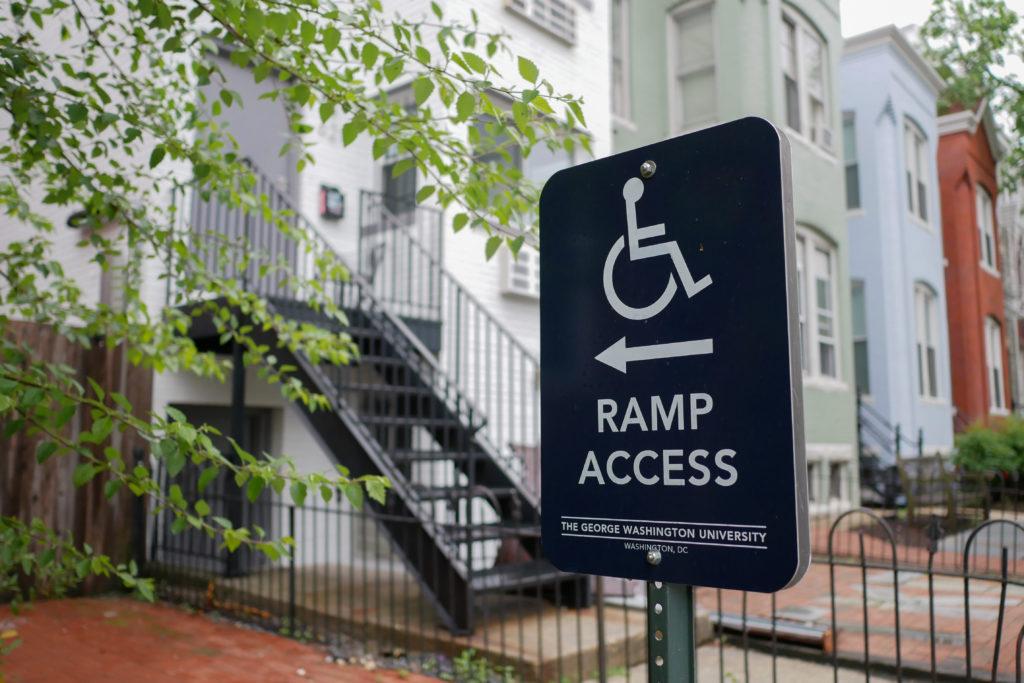Officials are updating virtual and physical campus maps to include accessibility features like ramps and automatic doors.
David Dent, the associate vice president of facilities planning, construction and management, said online campus maps will be revamped “in the coming days” to mark handicap parking signage, buildings with ramp entrances and restrooms and elevators that physically handicapped people can use. SA leaders said the updates will help visitors and prospective students familiarize themselves with campus routes and learn about campus accessibility before they can physically visit GW.
Dent said the physical maps scattered throughout campus will be replaced with the updates in the “coming weeks.”
“We appreciate the dialogue with our students as we continue to work together to enhance our University,” Dent said in an email. “We look forward to continuing to work with our students and staff to further broaden resources that enhance accessibility on campus.”
SA Executive Vice President Amy Martin said she worked with SA President SJ Matthews to report areas, like accessible elevators and handicap parking spaces, that should be highlighted on campus maps to help students with physical disabilities know which buildings are accessible and help them plan travel routes.
“It is not only helpful for current students but obviously prospective students because a lot of time they’ll look at those maps as they walk around,” Martin said.
She added that administrators like Dent and Mark Diaz, the chief financial officer and executive vice president, took in her and Matthews’ input to improve the map in addition to other campus changes. Officials are currently constructing a gender neutral bathroom following SA advocacy, Martin said.
“The gender-neutral bathroom in the Marvin Center is a great example of progress, and the fact that they are currently and actively finishing up this project is another great example,” she said.
Last semester, SA leaders vouched for lips on sidewalks – a feature for students in wheelchairs to level the base of a ramp and smoothen out a path. The SA also worked with officials on making several updates to campus facilities, including additional lighting on the Mount Vernon Campus.
Campus management and student disability experts said open communication between students and faculty will help administrators identify areas to bolster accessibility.
Tom Merrell, the assistant dean and director of Student Disability Services at the University of San Francisco said his university is also updating the campus accessibility map and assessing areas, like accessible bathrooms, that may need support. Merrell said administrators walked through the campus and documented places, like bathrooms without stalls for physically handicapped students, that needed improvements.
“Accessibility affects everyone, not just people with disabilities,” he said. “The more people understand this, the more accessible our world will be.”
He added that the University of San Francisco is situated in an urban environment surrounded by hills, which poses mobility issues for students with a physical disability. Students said that the Vern’s hilly landscape and lack of stairs in some residence halls renders the campus very inaccessible for students with disabilities.
Merrell said officials send out biennial student surveys to inform the disability support office of areas that need to be addressed. Students can also contact the school’s disability support office directly with concerns and suggestions for increasing accessibility, he said.
“It’s really important for both the school and the students to keep an open line of communication when talking about campus accessibility,” Merrell said. “It’s also very important for students to feel comfortable and heard when voicing concerns about access at their school.”
Josh Lindenstein, the assistant director of communications and a campus spokesperson at the University of Colorado, Boulder, said his school’s online campus map features accessible parking and entrance access in accordance with the Americans with Disabilities Act of 1990, which prohibits disability discrimination.
He said Boulder’s “campus partners” facilitate audits each summer of each building’s entrances to ensure the campus map has the most up-to-date information about the school’s ADA-compliant features.
The University fell under investigation in April 2017 for alleged disability discrimination. The probe wrapped up that summer, and officials said they will update their websites to ensure the content is accessible.
“In terms of challenges to updating the map, the biggest is probably just always making sure the data is current,” Lindenstein said.







